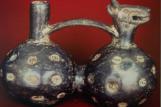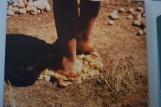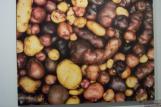2
Today, potatoes are Prince Edward Islands primary crop.Things were not always good for the potato crop. It is ironic that the Irish, fleeing the spectre of famine in Ireland in the 1840's found potato blight on the Island.
Prince Edward Island was the first province to produce seed potatoes and shipped its first load of seed potatoes in 1918. Today, more than half of Canada's seed potatoes come from P.E.I. and they are shipped to over twenty countries.
4
Potatoes are native to South America. The potato was first used as a source of food in the highlands of the Andes perhaps as early as 10 thousand years ago. Evidence for the great antiquity of potato cultivation is supported by pottery made by the Mochica, Chima and Inca cultures which flourished on the northern coast of Peru.6
Pottery pieces were made to resemble potatoes and sometimes showed potatoes with human characteristics. The potato was also believed to have medicinal qualities and was rubbed on the skin of sick patients as a remedy. The Inca people worshipped potato gods and celebrated rituals to ensure the success of the potato crops.7
The most efficient tool of the ancient Andean people was the taclla or foot plow.1600
from South America

8
The most efficient tool of the ancient Andean people was the taclla or foot plow.Cultivation of the potato involved turning the sod with a foot plow, into which the weight of the body would be thrown. This plow was called a taclla and was made of wood. An assistant would turn the sod over after it had been cut. The implement was 5 or 6 feet high and the pointed tip was hardened by fire or covered in copper. Two handle like projections were bound to this shaft, one for the foot and the other for the arm. The taclla, now with an iron blade, is still used today.
10
The Andean native people practiced crop rotation on a regular basis; thereby never impoverishing the land. At the time of the Spanish conquest they may even have developed frost resistant varieties. Some of the varieties of potatoes were cut up, left on the ground overnight to freeze and later dried by being walked on, thus squeezing the water from the cells of the potato. The resulting product was called Chuno and could be stored for long periods of time. It was usually eaten as it was or in a stew called Chupa.13
The Spanish conquerors of America were lured to South America by the tales of realms of silver and gold but history demonstrated that the real treasures the Spaniards appropriated in South America was the lowly potato. The potato has benefited the human race far more than all the gold and silver pillaged from the Inca people.The first written record of a European encounter with potatoes was penned in 1537 by Castellanos, a Spanish Conquistador. After raiding a village in South America, Castellanos and his party found the area deserted and entered the houses in search of loot. Instead of silver and gold, they found maize, beans and truffles(which we know today as potatoes).






